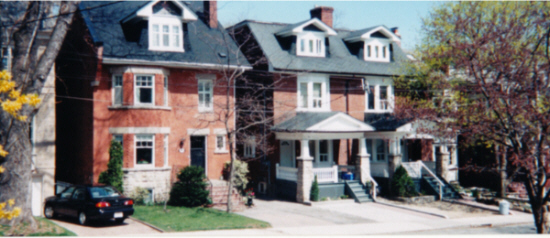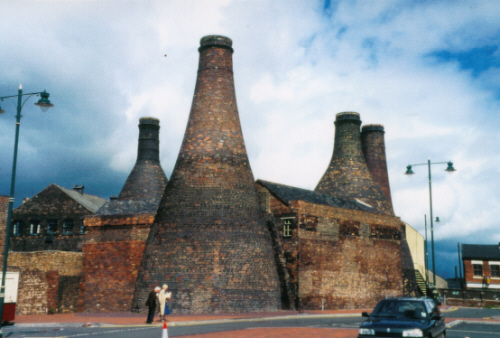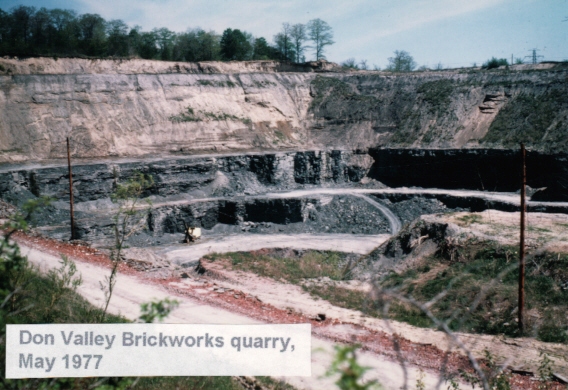Brick making is an ancient trade. We read in the Bible of the problems the Israelites had making mud bricks for Pharaoh. Mud bricks dried in the sun are still being made in Egypt today, but when we think of bricks we think of bricks made of clay and fired in an oven to make them hard. Houses made of brick are the rule in Toronto especially after the disastrous fires of the nineteenth and early twentieth centuries. Many of the historic houses described in this web site are made of brick. Three examples are Ferguson House, Snider House, and Caverhill. Below is a picture of brick residences of a style frequently seen in central Toronto.

In the two plus centuries since settlement began numerous potteries and brick making establishments have operated in the Toronto area. While some manufactured bricks other made other forms of pottery. Early potteries noted in this website include: establishments of the Pears family in Yorkville and at the site of Eglinton Park; Walmsley’s Pottery near Davisville; Math Parsons’ on his farm near Fairbank and The Don Valley Brick Works. There were many others. By 1912, 40 per cent of Ontario’s brick was made in 34 brickyards at and on the edges of Toronto with The Don Valley Brick Works leading with the production of over 43-million brick. The next largest plant produced 15 million.

Brick making changed over the years. The early brick makers probably used simple molds to form their bricks and fired them in beehive kilns similar to those in the picture above. Progressive manufacturers like the Taylors who owned and managed The Don Valley Brick Works, utilized the latest methods in many ways. This included mechanising the forming of the bricks and the use of continuous downdraft kilns. Hand digging gave way to steam shovels which were replaced by diesel power. Simple methods of grinding and mixing were replaced by advanced processes using the latest machinery.

Over the century the Don Valley plant operated, from 1889 when it started as a soft-mud brick plant, until it ceased production in 1989, its management regularly improved processing methods. Successful experiments in making pressed brick using shale resulted in a major plant expansion and the opening of the lower shale quarry shortly after the plant started. It was no longer dependant on the over laying glacial clays and sands. The Don Valley Brick Works received international recognition for the quality of its products in the 1890s. By the 1970s, while some clay was still available in the upper levels of the quarry, and continued to be used, shale had became the major raw material. It is of interest to note that the while the buff coloured glacial clays produced yellow bricks, the blue shale produced red bricks.
In 1912, some brick was still formed in sanded molds, but much was wire-cut brick. This is cut off in brick size from a continuous column of clay by wires. Hollow block brick was made in the same fashion as wire-cut brick, but with different dies that made holes in the column of clay. Wire-cut required drying before firing so were placed on steel cars and taken to tunnel dryers from which they went to down-draft kilns. The dry-pressed bricks could go directly from the presses to the kiln, as they require no drying. There were single, double, and continuous kilns burning wood and soft coal, except for an enormous continuous kiln, burning gas. The brick was in the kilns for seven to ten days followed by a cooling period.
Among the various products of the Don Valley Brick Works were: softmud, stiff- mud bricks or wire-cut, dry pressed bricks, sand-lime bricks, decorative terracotta tiles and structural hollow block pieces. Under the Taylors, a wide variety of clay brick was available in ten shades of red, seven shades of buff, plus olive gold, brown obsidian and mottled. It was the first, and for many years the only plant in Canada, to make glazed (enamelled) bricks and the first to install arch grinding machines to supply brick ground to order for flat, elliptical or circular arches. Their exhibit at the World’s Columbian Exposition at Chicago in 1893 won two gold medals, for brick and for terracotta, and they won a gold medal for their exhibit at the Toronto Industrial Fair of l894. This plant produced a wider variety of bricks and kiln fired clay products than any other brick plant in Ontario. Daily production increased from 44,000 bricks in 1891 to 120,000 by 1912. The processes used in the 1960s for producing the four major products: stiff-mud brick, dry press brick, soft-mud brick and sand-lime brick are briefly described below.
Stiff-mud brick are made with either clay or ground shale, tempered to a stiff consistency; more water is required than for dry-press brick, but less than for soft-mud brick. The batch is driven by an auger through a die, and bricks are cut from the extruded clay column by wires. The process is continuous, and large auger machines are capable of producing more than 20,000 brick per hour. The bricks were manually stacked onto cars for transfer to a holding room where they were heated to 100°F (42.5°C). Brick surface textures were made by scratching with steel points (rug brick) or embossing designs by rollers as the clay column left the extruders. The cars were then sent through a tunnel dryer, before entering natural gas fired 376-foot long tunnel kilns. If the green brick were not dried, contained moisture could turn to steam in the tunnel kiln and blow the bricks apart. The cars were pushed one at a time into an entering chamber with the inner door shut. Once in place, the outer door was closed and the inner door opened to allow the car to enter a preheat zone, then a firing zone, a bleaching-reducing zone, and a forced draft cooling zone. Each kiln could hold 38 cars and operated at the rate of 16 cars per day – or about 2.5 days of burning per car. As the top of the kiln was hotter than the bottom, the colour of the brick varied from darker colours at the top of a stacked car to lighter colours at the bottom. After exiting the kiln, the cars of fired brick were transferred to a waiting area, where after cooling enough to be handled they were sorted by colour into cubes of 500 on pallets. Fork lifts then transferred the loaded pallets to storage sheds until they were shipped to construction sites.
Dry-press brick were usually made from ground shale, tempered with only a small amount of water. Bricks were formed under pressure in steam-heated steel moulds; pressure applied by an overhead steel plunger provides cohesion to the brick in lieu of sufficient water for plasticity. Dry-press machines make four to six bricks with each cycle, and are capable of making 2,000 brick per hour. At the Don Valley Brick Works, the clay, which was conveyed to a mixer where water was added to 5 to 8 per cent moisture content. This mixture was thenconveyed to presses. After pressing, the green bricks were sorted and loaded onto cars. Those bricks to be glazed were transported to a spray hood for an enamel glaze application. Coloured enamels were formulated from various oxides and ceramic stains in a glaze mixing room. Glazed brick received an even coat of colour over the surface(s) required, “Glazetex” brick received a splattered glaze that coated 80 to 85 per cent of the surface(s). These brick then travelled by conveyor through a preheater hood where they were baked to 450°F (260°C), which allowed gently handling and loading of 1100 bricks per car for firing in a 212 foot long tunnel kiln. This
kiln operated on Bunker C fuel oil to a peak firing temperature of 1850°F (1130°C) and could accommodate 79 cars at a rate of 14 cars per day. Later 376 foot long natural gas tunnel kilns firing to 1880°F were installed. After cooling, the bricks were sorted into 500 brick cubes and stored awaiting shipment.
The soft-mud process requires a sandy clay, tempered with a large amount of water, so the batch will flow readily into sand-dusted wood moulds. Soft-mud machines make five bricks with each cycle and are capable of making 2,000 brick per hour. The method is essentially a refinement of the older slop-mud process, in which bricks were made by hand in individual wood moulds. As late as 1906, a few brickyards were still in using the slop-mud process. At the Don Valley Brick Works, soft-mud “John Price” bricks were made by tempering a clay-sand mixture with up to 30 per cent water. Twenty steel knives on a vertical shaft forced the clay mixture down to where wipers on the shaft forced the clay into the press box and a plunger pressed the clay to completely fill a five brick mold. The plunger could be adjusted to one of four pressures. A filled mold was ejected as an empty freshly sanded mold was inserted. Small amounts of borax, ferro-red or manganese dioxide were added to the sand, as required, to produce the desired colour. The machine could produce up to 3000 brick per hour, but usually production was in the vicinity of 2400 bricks per hour. The green bricks were dumped five at a time on boards and shelved into racks on a narrow, 24” gauge dryer car that held 200 bricks. These bricks were dried in a special tunnel dryer heated to about 200°F before they were loaded onto tunnel kiln cars and fired in one of the smaller tunnel kilns.
In making Sand-Lime Brick, measured quantities of sand and lime were thoroughly mixed to a 3- 6 % water content and fed into areactor where the lime was converted from CaO to Ca(OH)2. After psssing through a rod mill, the mixture was transferred to presses where bricks were pressed in die boxes. The bricks were then loaded in quantities of 1335 onto cars which were fed into large (7-foot diameter, 75-foot long) steel autoclaves. Within each autoclave, 12 cars with 16,000 bricks were subjected to dry steam at 250 psi for 8 hours to create bricks of calcium silicate compounds. After cooling, the bricks were sorted and packaged into cubes of 500.
